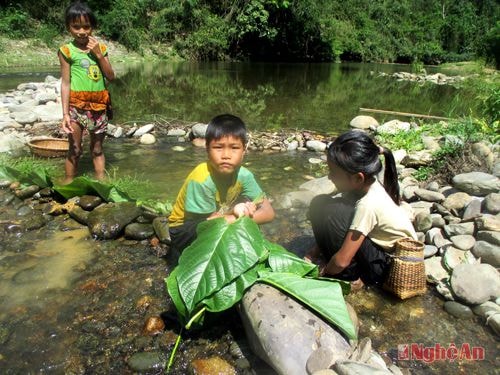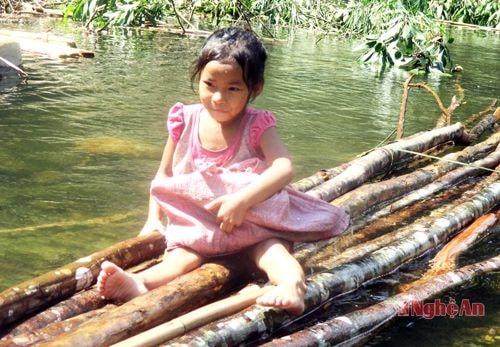Children in Khe Bu
(Baonghean) - Dropping out of school early, going to the forest or fields, even going down to the stream to pan for gold are "normal" things for Dan Lai children in Khe Bu village (Chau Khe - Con Cuong). That is the lingering feeling in my mind after my trip back to the village to visit this community.
"Son of God"
“They are all children of God.” That is the metaphor of Ms. Lo Thi Mai, a Khe Bu villager, talking about the children of her community. During the “great heat” season, the temperature outside reaches forty degrees, the children are still naked and exposed to the sun. It seems that the lack of food and clothing, the harsh summer sun does not affect their joy of life. It can be seen that when entering this village, you will only see… children. It is as if this small village is the children’s own world. They look out from the windows, hang around under the stilt houses, on the concrete road, hang around in the stream bed. Most of the adults are in the forest. They leave early in the morning and return home late at night, sometimes even sleep there to look for forest products and catch bees.
 |
| Khe Bu children catch fish on Nam Pu stream. |
The village has over a hundred houses and couples of reproductive age often have more than two children. The older child has not yet been weaned, the younger one is born quickly. The children of the forest grow up innocently like wild seedlings.
Although not yet 40 years old, Ms. Lo Thi Mai is already a grandmother. Her two eldest daughters are both married. The second daughter has just turned 18 but already has a 14-month-old baby on her back.
Although not in a difficult situation, Ms. Mai's family has a hard time raising two children, one of whom is a boy, a grandchild just over 1 year old. The youngest son has just finished 5th grade. The couple makes a living by whittling chopsticks for restaurants, weddings in the district town, or selling them retail to passersby who prefer chopsticks whittled from certain types of forest wood. They also sell traditional medicine to treat joint pain and broken bones for people in the area. "Thanks to these jobs, my youngest son can go to school with peace of mind," said Mr. Vi Van Tam, Ms. Mai's husband.
In the village, there are quite a few children who only finish grade 5 and then stay at home. If they want to go to secondary school, they have to go to the commune center, 20 km away from the village. There, the accommodation for students is relatively decent, but it seems that attracting Dan Lai students to continue studying is quite difficult because parents are not very interested in their children's education. There is a reason why parents do not care about sending their children to school, an old woman who has been selling groceries in the village for many years said: People here think: "We live in the mountains, knowing how to read and write is enough, why do we need a secondary or high school degree?"
Under the stream…
The youngest son of Ms. Lo Thi Mai’s family is named Vi Van Uoc, the son the family has been waiting for. In the village, names like Uoc, Dat, Mong, Hiem, Yeu, Quy… are not rare. The psychology of parents still wishes for a son to have support in the future.
Uoc is a rather hyperactive boy. After the initial hesitation, he came to whisper in my ear on the Nam Pu stream near my house where there were many children. This was the coolest stream in the area so everyone wanted to go there to swim to dispel the scorching summer heat. I guessed so, but it was only partly true…
 |
| Baby Ha Van plays on the raft |
I walked quickly after the boy who was skipping to the stream. The confluence of Nam Pu and Khe Choang streams created a small body of water, quite bustling with people. They held in their hands handmade gold panning tools such as wooden sieves, shovels, hoes, spades, etc. The villagers gathered here from early morning to search for gold dust under the stream bed. According to the gold panners, this job on a lucky day can help them earn a few centimeters of gold. However, the number of days when they returned empty-handed was often higher than the number of lucky days.
There are quite a few children who join the gold panning “army”. Most of them are still primary school students. During school holidays, the children see panning for gold in the stream as a way to help their parents. For some children, whether they find gold or not is not important. They participate in the work just as a game.
This year, 14-year-old La Thi Huyen said she had dropped out of school since entering 6th grade. On days when she was not going to the forest to look for bamboo shoots or catch bees, she followed her family down to the stream to pan for gold. If she was lucky, one day she could still help her family earn a few hundred thousand. Huyen said she started following her parents down to the stream to learn how to pan for gold when she was in elementary school. Another Dan Lai boy, La Van Vong, just entering 3rd grade, also knew how to hold a wooden sieve to pan for gold. Standing in the stream right next to Vong was a boy about 4 years old. The boy followed his brother and his family down to the stream because there was no one to look after him at home.
After a few quick conversations with the gold panning children, the boy Uoc led us upstream. A raft carrying firewood passed by. Sitting precariously on the raft was a little girl of kindergarten age. She boldly introduced herself as Ha Van, wearing a very “fashionable” pink dress, and said she was returning from gathering firewood with her mother. The young mother explained: “If I let her stay at home, she might go and play around and fall into the stream. It’s also scary to let her go with me, but having an adult is still safer.” The little girl who was kicking her feet in the water suddenly interjected: “I want to go to the forest with my mother.” Perhaps for a lively girl like Ha Van, going to the forest with her mother is like going to the park for city children.
On another stream, a group of children went fishing. Little La Thi Ngoan, who had just finished 4th grade, appeared to have more experience in fishing than her friends. Ngoan gathered the group to choose a small stream and arranged rocks to block the water flow in another direction. She used leaves and rubbish to cover the gaps to prevent the stream water from seeping down. After only half an hour, the stream below dried up, and the children were free to fish. This way of fishing has been used by the villagers for many generations. Having to help her parents with housework, Ngoan also learned the fishing experience of adults early.
The children on the Nam Pu stream that we met were mostly 9 or 10 years old, but they had already jumped into the struggle to make a living with innocence. Some people might think that they were being treated unfairly because they were all at the age of eating, sleeping, and studying. But life in the highlands, especially in communities living close to nature like the Dan Lai people, has been like this for generations. Every person born from the time they can walk has to learn how to earn their own daily meals…
You Wei






